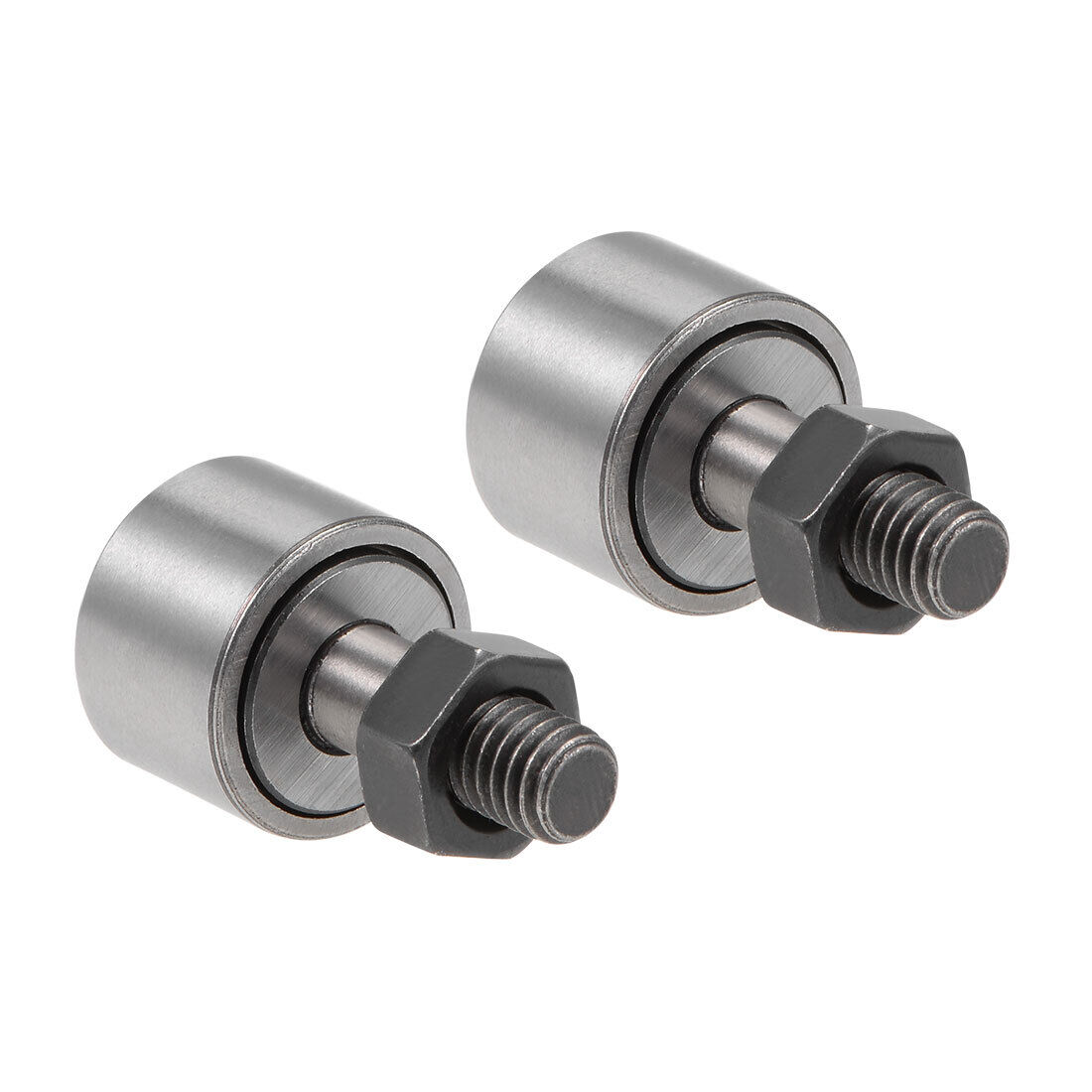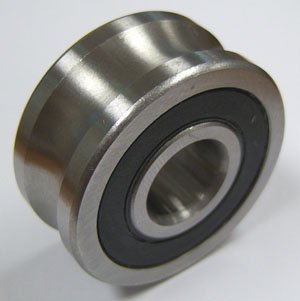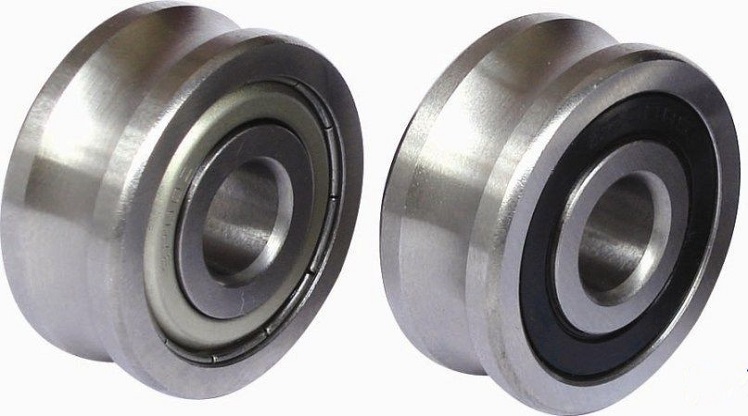Product Description
PRODUCTS CATALOGUE
RUNSTAR also supply high precision Cam Follower Needle Roller Bearing/Stud Type Needle Roller Bearings as followings.
| Bearing Number | Bearing Dimension | eccentricity | Basic Load Rating | weight g | |||||||||||
| D | C | G | D1 | G1 | B max | B1 max | B2 | C1 | Dynamic C(kfg) | Static Co(kfg) | |||||
| NO: 1 | NO: 2 | NO: 3 | |||||||||||||
| CF5 | KR13 | KRV13 | 13 | 9 | 5 | M5x0.8 | 7 | 10 | 23 | 13 | 0.5 | 0.25 | 280 | 180 | 16 |
| CF6 | KR16 | KRV16 | 16 | 11 | 6 | M6x1 | 8 | 12.2 | 28.2 | 16 | 0.6 | 0.25 | 270 | 170 | 18 |
| CF8 | KR19 | KRV19 | 19 | 11 | 8 | M8x1.25 | 10 | 12.2 | 32.2 | 20 | 0.6 | 0.25 | 300 | 210 | 28 |
| CF10 | KR22 | KRV22 | 22 | 12 | 10 | M10x1.25 | 12 | 13.2 | 36.2 | 23 | 0.6 | 0.3 | 410 | 320 | 44 |
| CF10-1 | KR26 | KRV26 | 26 | 12 | 10 | M10x1.25 | 12 | 13.2 | 36.2 | 23 | 0.6 | 0.3 | 410 | 320 | 58 |
| CF12 | KR30 | KRV30 | 30 | 14 | 12 | M12x1.5 | 13 | 15.2 | 40.2 | 25 | 0.6 | 0.3 | 590 | 450 | 108 |
| CF12-1 | KR32 | KRV32 | 32 | 14 | 12 | M12x1.5 | 13 | 15.2 | 40.2 | 25 | 0.6 | 0.3 | 590 | 450 | 118 |
| CF16 | KR35 | KRV35 | 35 | 18 | 16 | M16x1.5 | 17 | 19.6 | 52.1 | 32.5 | 0.8 | 0.35 | 850 | 760 | 169 |
| CF18 | KR40 | KRV40 | 40 | 20 | 18 | M18x1.5 | 19 | 21.6 | 58.2 | 36.5 | 0.8 | 0.35 | 1180 | 1220 | 247 |
| CF20 | KR47 | KRV47 | 47 | 24 | 20 | M20x1.5 | 21 | 25.6 | 66.1 | 40.5 | 0.8 | 0.35 | 1630 | 1690 | 386 |
| CF20-1 | KR52 | KRV52 | 52 | 24 | 20 | M20x1.5 | 21 | 25.6 | 66.1 | 40.5 | 0.8 | 0.35 | 1630 | 1690 | 461 |
| CF24 | KR62 | KRV62 | 62 | 29 | 24 | M24x1.5 | 25 | 30.6 | 80.1 | 49.5 | 0.8 | 0.4 | 2160 | 2210 | 790 |
| CF24-1 | KR72 | KRV72 | 72 | 29 | 24 | M24x1.5 | 25 | 30.6 | 80.1 | 49.5 | 0.8 | 0.4 | 2160 | 2210 | 1040 |
| CF30 | KR80 | KRV80 | 80 | 35 | 30 | M30x1.5 | 32 | 37 | 100 | 63 | 1 | 0.5 | 2830 | 3700 | 1550 |
| CF30-1 | KR85 | KRV85 | 85 | 35 | 30 | M30x1.5 | 32 | 37 | 100 | 63 | 1 | 0.5 | 2830 | 3700 | 1740 |
| CF30-2 | KR90 | KRV90 | 90 | 35 | 30 | M30x1.5 | 32 | 37 | 100 | 63 | 1 | 0.5 | 2830 | 3700 | 1950 |
OUR WORKSHOP
OUR FACTORY
PACKAGING
/* January 22, 2571 19:08:37 */!function(){function s(e,r){var a,o={};try{e&&e.split(“,”).forEach(function(e,t){e&&(a=e.match(/(.*?):(.*)$/))&&1
| Cage: | With Cage |
|---|---|
| Rows Number: | Single |
| Load Direction: | Radial Bearing |
| Samples: |
US$ 5/Set
1 Set(Min.Order) | Order Sample |
|---|
.shipping-cost-tm .tm-status-off{background: none;padding:0;color: #1470cc}
|
Shipping Cost:
Estimated freight per unit. |
about shipping cost and estimated delivery time. |
|---|
| Payment Method: |
|
|---|---|
|
Initial Payment Full Payment |
| Currency: | US$ |
|---|
| Return&refunds: | You can apply for a refund up to 30 days after receipt of the products. |
|---|

What are the considerations for selecting the right track bearings for a particular application?
Selecting the right track bearings for a particular application requires careful consideration of various factors to ensure optimal performance, reliability, and longevity. Here are the key considerations to keep in mind:
- Load Requirements: Assess the expected load conditions in the application. Consider both the static and dynamic loads that the track bearings will need to support. Determine the maximum load capacity required to ensure that the selected bearings can handle the anticipated loads without premature failure or excessive wear.
- Speed and Acceleration: Evaluate the speed and acceleration requirements of the application. Higher speeds and rapid accelerations can impose additional stresses on the track bearings. Choose bearings with suitable speed and acceleration ratings to ensure they can operate effectively within the desired range without compromising performance or causing premature wear.
- Environmental Factors: Consider the operating environment of the application. Evaluate factors such as temperature extremes, moisture, dust, chemicals, and potential exposure to corrosive substances. Select track bearings that are designed to withstand the specific environmental conditions to ensure optimal performance and longevity.
- Track and Rail Compatibility: Assess the compatibility of the track bearings with the existing track or rail system. Consider factors such as track geometry, dimensional requirements, and mounting options. Ensure that the selected bearings are suitable for the specific track or rail design to facilitate proper installation, alignment, and smooth operation.
- Maintenance and Lubrication: Evaluate the maintenance and lubrication requirements of the track bearings. Consider factors such as the need for regular maintenance, lubrication intervals, and the availability of suitable lubricants. Choose bearings that align with the desired maintenance practices and provide appropriate lubrication options based on the application’s operational demands.
- Expected Lifespan and Reliability: Determine the desired lifespan and reliability expectations for the track bearings. Consider factors such as the projected operating hours, duty cycles, and the criticality of the application. Select bearings from reputable manufacturers known for producing high-quality, reliable products that align with the expected lifespan and reliability requirements.
- Cost Considerations: Evaluate the cost-effectiveness of the track bearings. Consider the initial purchase cost as well as the long-term costs associated with maintenance, replacement, and potential downtime. Strive for a balance between the upfront investment and the overall value provided by the bearings in terms of performance, reliability, and longevity.
It is essential to consult with bearing manufacturers or industry experts who can provide guidance and recommendations based on the specific application requirements. By considering these factors and seeking expert advice, you can select the right track bearings that best meet the needs of your particular application.

How do track bearings contribute to the precision, accuracy, and reliability of motion control systems?
Track bearings play a crucial role in enhancing the precision, accuracy, and reliability of motion control systems. They provide several key contributions that ensure smooth and consistent linear motion. Here’s a detailed explanation:
- Precision Guidance: Track bearings offer precise guidance for linear motion systems. They are designed with close tolerances and accurate geometries, allowing for accurate positioning and control of the moving components. This precision guidance ensures that the desired motion is achieved with minimal deviation or error.
- Smooth and Consistent Motion: By minimizing friction and providing smooth rolling or sliding surfaces, track bearings enable smooth and consistent motion in motion control systems. They reduce the effects of irregularities, misalignments, or vibrations, resulting in smoother operation and improved accuracy.
- Repeatable Performance: Track bearings provide repeatable performance in motion control systems. They offer consistent and predictable motion characteristics, allowing for precise and repeatable positioning of the moving components. This repeatability is essential in applications that require high accuracy and consistency, such as CNC machining, semiconductor manufacturing, and precision measurement systems.
- Load Distribution: Track bearings distribute the load evenly along their length, helping to minimize stress concentrations on specific components. This even load distribution improves the overall stability and reliability of the motion control system. It reduces the risk of component failure, deformation, or excessive wear, contributing to enhanced system reliability.
- Minimized Play and Backlash: Track bearings are designed to minimize play and backlash, which are undesirable movements or clearances between components. Play and backlash can introduce inaccuracies and reduce the precision of motion control systems. Track bearings with tight tolerances and optimized designs help minimize these undesirable effects, ensuring precise and accurate motion.
- Stiffness and Rigidity: Track bearings provide stiffness and rigidity to the motion control system. They resist deflection and maintain their shape under load, minimizing any unwanted flexing or bending. This stiffness enhances the overall stability and precision of the system, allowing for precise control and accurate motion even under varying loads or external forces.
- Resistance to Contamination: Track bearings are often equipped with seals or shields to protect against contaminants such as dirt, dust, or liquids. This protection helps maintain the precision and reliability of the motion control system by preventing the ingress of particles that could interfere with the smooth operation of the bearings or cause premature wear and failure.
By incorporating track bearings into motion control systems, industries can benefit from improved precision, accuracy, and reliability. Whether it’s achieving precise positioning, ensuring consistent and repeatable motion, minimizing play and backlash, or providing reliable load distribution, track bearings contribute to the overall performance and integrity of motion control systems.

How do track bearings contribute to smooth and precise motion in machinery and equipment?
Track bearings play a crucial role in enabling smooth and precise motion in machinery and equipment. They provide support and guidance for moving components, allowing them to move along tracks or guide rails with minimal friction and accurate positioning. Let’s explore how track bearings contribute to smooth and precise motion:
- Reduced Friction: Track bearings are designed to minimize friction between the rolling elements (such as balls or rollers) and the raceways (inner and outer rings). By reducing friction, track bearings help to minimize energy losses, prevent excessive heat generation, and extend the lifespan of the bearing and other components in the system. Low friction enables smoother and more efficient motion, resulting in improved overall performance.
- Accuracy and Precision: Track bearings are manufactured to precise tolerances, ensuring consistent dimensions and smooth surfaces. This precision contributes to accurate and repeatable positioning of the moving components along the track or guide rail. It allows machinery and equipment to achieve the desired motion with minimal deviation or backlash, enabling precise control and operation.
- Load Distribution: Track bearings are designed to distribute loads evenly across the rolling elements and raceways. This load distribution helps prevent localized stress concentrations and ensures that the applied loads are shared by multiple contact points. By distributing the loads effectively, track bearings enhance the stability and integrity of the moving components, reducing the risk of premature wear or failure.
- Guidance and Alignment: Track bearings provide guidance and alignment for the moving components. They help maintain the desired orientation and position of the components along the track or guide rail, preventing misalignment and unwanted movements. This guidance ensures smooth and precise motion, minimizing vibrations, noise, and the risk of component damage or malfunction.
- Shock and Impact Absorption: Track bearings are designed to absorb shocks and impacts that may occur during operation. They help cushion the effects of sudden loads or vibrations, protecting the moving components and reducing the transmission of these forces to the rest of the machinery or equipment. This shock absorption capability contributes to smoother and more stable motion, enhancing overall performance and reliability.
By incorporating high-quality track bearings into machinery and equipment, engineers can achieve smooth and precise motion, improving the efficiency, accuracy, and longevity of the system. Proper selection, installation, and maintenance of track bearings are essential to ensure optimal performance and to minimize the risk of issues such as excessive wear, misalignment, or loss of motion control.


editor by CX 2024-05-16